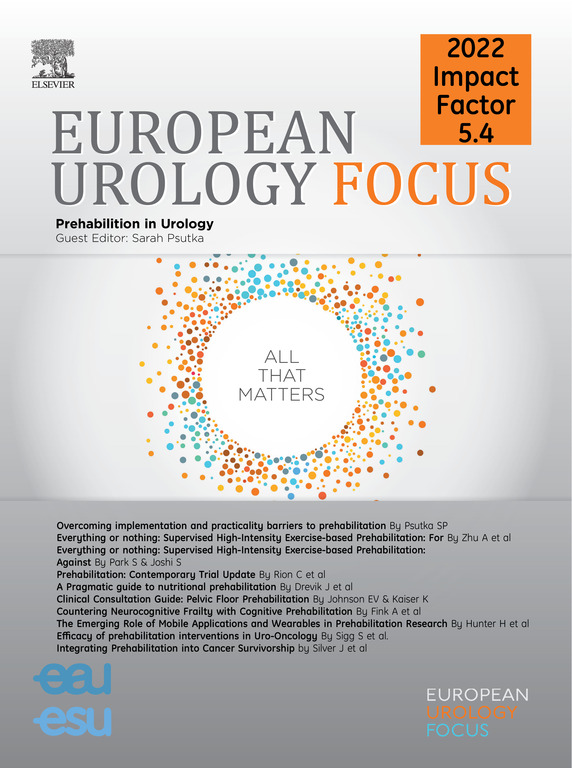良性前列腺梗阻继发下尿路症状外科治疗的新兴技术。系统回顾。
摘要
背景:下尿路症状(LUTS)/良性前列腺梗阻(BPO)的外科治疗旨在通过切除、摘除或汽化切除前列腺腺瘤。除了根据欧洲泌尿外科协会指南建立的消融模式外,各种技术已经成为安全/有效的替代方案,但仍在研究中。目的:探讨LUTS/BPO手术管理新兴技术的短期益处/危害。证据获取:截至2022年6月18日,通过Ovid使用MEDLINE、EMBASE和CENTRAL进行了系统的文献检索。我们纳入了随机对照试验(RCTs),探讨了膀胱切除术、前列腺动脉栓塞术(PAE)、Rezum、前列腺尿道提升术(PUL)和临时植入式镍钛诺装置(iTIND)与假/经尿道前列腺电切术(TURP)的对比。证据综合:我们纳入了10项随机对照试验,共1108名男性。膀胱切除术与经尿道前列腺电切术:国际前列腺症状评分(IPSS;平均差[MD]0.0,95%置信区间[CI]-2.44至2.44)、生活质量(生活质量;MD 0.30,95%CI-0.81至0.21)、最大尿流率(Qmax;MD-0.30,95%CI-3.71至3.11)、再治疗(风险比[RR]0.18,95%CI 0.02-1.66)、,和尿失禁(UI;RR 0.71,95%CI 0.26-1.95)。PAE与单极经尿道前列腺电切术(M-TURP)相比:IPSS(MD 3.33,95%CI-28.39至35.05)、QoL(MD 0.12,95%CI-0.30至0.54)、国际勃起功能指数(IIEF-5;MD 3.07,95%CI-1.78至7.92)和UI(RR 0.15,95%CI 0.01-2.86)的变化不显著,Qmax(MD-9.52,95%CI-14.04至-5.0)的变化显著,有利于M-TURP。PAE与双相TURP相比:IPSS(MD-2.80,95%CI-6.61至1.01)、生活质量(MD-0.69,95%CI-1.46至0.08)、Qmax(MD-3.51,95%CI-8.08至1.06)、UI(RR 0.14,95%CI 0.01-2.51)和再治疗(RR 1.91,95%CI 0.19-19.63)的变化不显著,IPSS(MD 3.40,95%CI 0.22-6.58)、IIEF-5(MD 3.00,95%CI 0.41-5.59)和Qmax(MD-9.60,95%CI-13.44至-5.76)发生显著变化,分别有利于PUL和TURP。迄今为止,Rezum和iTIND尚未在对照TURP的随机对照试验中进行评估。结论:临床应用aquablation、PAE、PUL、Rezum和iTIND的支持证据非常有限。应在高质量随机对照试验中进一步调查益处/危害。患者总结:本综述总结了临床使用膀胱切除术、前列腺动脉栓塞术(PAE)、前列腺尿道提升术(PUL)、Rezum和临时植入镍钛诺装置(iTIND)治疗良性前列腺梗阻继发下尿路症状的证据。aquablation、PAE、PUL、Rezum和iTIND临床应用的支持证据非常有限。应在高质量的随机对照试验中进一步研究其益处和危害。Context
Surgical management of lower urinary tract symptoms (LUTS)/benign prostatic obstruction (BPO) aims at ablating prostate adenoma by resection, enucleation, or vaporisation. Apart from established ablation modes according to the European Association of Urology guidelines, various technologies have emerged as safe/effective alternatives but remain under investigation.
Objective
To explore short-term benefits/harms of emerging technologies for surgical management of LUTS/BPO.
Evidence acquisition
A systematic literature search was conducted using MEDLINE, EMBASE, and CENTRAL via Ovid up to June 18, 2022. We included randomised controlled trials (RCTs) exploring aquablation, prostatic arterial embolisation (PAE), Rezum, prostatic urethral lift (PUL), and temporary implantable nitinol device (iTIND) versus sham/transurethral resection of the prostate (TURP).
Evidence synthesis
We included ten RCTs (1108 men). Aquablation versus TURP: insignificant change in International Prostate Symptoms Score (IPSS; mean difference [MD] 0.0, 95% confidence interval [CI] –2.44 to 2.44), quality of life (QoL; MD 0.30, 95% CI –0.81 to 0.21), maximum urinary flow rate (Qmax; MD –0.30, 95% CI –3.71 to 3.11), retreatment (risk ratio [RR] 0.18, 95% CI 0.02–1.66), and urinary incontinence (UI; RR 0.71, 95% CI 0.26–1.95). PAE versus monopolar TURP (M-TURP): insignificant change in IPSS (MD 3.33, 95% CI –28.39 to 35.05), QoL (MD 0.12, 95% CI –0.30 to 0.54), International Index of Erectile Function (IIEF-5; MD 3.07, 95% CI –1.78 to 7.92), and UI (RR 0.15, 95% CI 0.01–2.86), and significant change in Qmax (MD –9.52, 95% CI –14.04 to –5.0), favouring M-TURP. PAE versus bipolar TURP: insignificant change in IPSS (MD –2.80, 95% CI –6.61 to 1.01), QoL (MD –0.69, 95% CI –1.46 to 0.08), Qmax (MD –3.51, 95% CI –8.08 to 1.06), UI (RR 0.14, 95% CI 0.01–2.51), and retreatment (RR 1.91, 95% CI 0.19–19.63). PUL versus TURP: insignificant change in QoL (MD 0.40, 95% CI –0.29 to 1.09), UI (RR 0.13, 95% CI 0.02–1.05), and retreatment (RR 0.48, 95% CI 0.12–1.86), and significant change in IPSS (MD 3.40, 95% CI 0.22–6.58), and IIEF-5 (MD 3.00, 95% CI 0.41–5.59) and Qmax (MD –9.60, 95% CI –13.44 to –5.76), favouring PUL and TURP, respectively. Rezum and iTIND have not been evaluated in RCTs against TURP to date.
Conclusions
Supporting evidence for clinical use of aquablation, PAE, PUL, Rezum, and iTIND is very limited. Benefits/harms should be investigated further in high-quality RCTs.
Patient summary
This review summarises the evidence for the clinical use of aquablation, prostatic arterial embolisation (PAE), prostatic urethral lift (PUL), Rezum, and temporary implantable nitinol device (iTIND) to manage lower urinary tract symptoms secondary to benign prostatic obstruction. The supporting evidence for the clinical usage of aquablation, PAE, PUL, Rezum, and iTIND is very limited. Benefits and harms should be investigated further in high-quality randomised controlled trials.

 求助内容:
求助内容: 应助结果提醒方式:
应助结果提醒方式:


